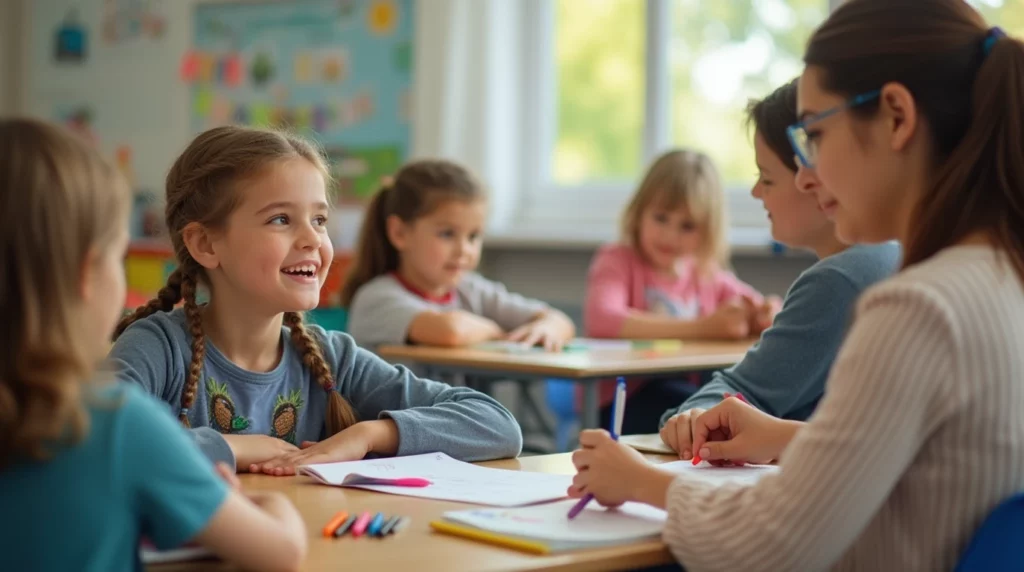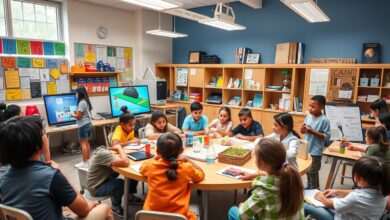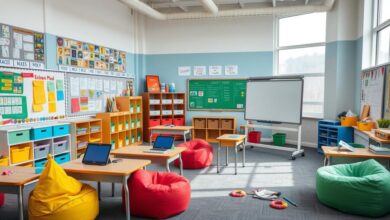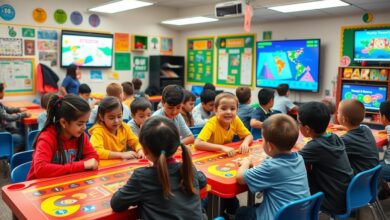Scaffolding in Education: Boost Student Learning & Growth

Education can be challenging at times, but scaffolding techniques offer significant support. Scaffolding is when teachers provide students with support as they learn new things, making the learning process easier by breaking down difficult tasks into simple steps.
Teachers use scaffolding in multiple ways to help students. It’s a great technique for all students, regardless of level or subject. If you are a teacher or a parent, learning how to use scaffolding can help students grow significantly.
Scaffolding in Education
A dynamic classroom scene illustrates various scaffolding techniques in education, with diverse students engaging in collaborative learning activities, colorful educational concept charts on the walls, interactive learning tools scattered around the room, and a teacher facilitating the learning environment, all in a bright, inspiring atmosphere.
Understanding the Basics of Educational Scaffolding
Scaffolding is a key teaching method that helps students learn beyond their self-initiated capabilities. It provides temporary support and guidance that assists students in tackling difficult tasks and concepts, leading to increased independence and mastery of material.
Key Components of Scaffolding in Learning
Effective scaffolding involves several important parts:
- Assessing students’ current knowledge and skills.
- Identifying the “Zone of Proximal Development” (ZPD) – the gap between what a student can do alone and what they can achieve with assistance.
- Tailoring instruction and support to meet the student’s specific needs within the ZPD.
- Gradually releasing responsibility as the student’s competence and confidence grow.
- Fostering active engagement and collaboration throughout the learning process.
The Educational Theory Behind Scaffolding

Scaffolding is based on the work of Lev Vygotsky and his Zone of Proximal Development. Vygotsky said that students learn best when they are challenged but not overwhelmed. They need a mentor or peer to help them. This approach, which focuses on social interaction and learning, is at the core of scaffolding.
Benefits for Students and Teachers
Using scaffolding in the classroom has many benefits for both students and teachers:
- Students become more engaged, motivated, and confident as they tackle challenging tasks with appropriate support.
- Scaffolding helps students develop critical thinking, problem-solving, and self-regulation skills.
- Teachers can better understand their students’ learning needs, allowing for customized instruction and support.
- The gradual release of responsibility helps students become independent learners, reducing their need for teacher assistance over time.
By understanding the basics of educational scaffolding, educators can create engaging learning environments that help students succeed and continue to learn throughout their lives.
The Role of Scaffolding in Education: A Comprehensive Overview
Scaffolding is one of the core teaching methods that helps all types of learners. It uses differentiated instruction to meet the needs of each student. This makes learning engaging and inclusive for everyone.
At the heart of scaffolding is instructional support. Teachers use scaffolding to help students grow. They start with simple tasks and gradually add more challenges. This helps students become independent and succeed in school.
Scaffolding includes many strategies like modeling and questioning. Teachers adjust these methods to fit each student’s learning style. This approach builds self-confidence and helps students achieve better results in school.
“Scaffolding is the temporary support given to a student to help them complete a task they cannot do on their own.”
Scaffolding is also essential for differentiated instruction. Teachers use it to tailor lessons to each student’s level and interests. This way, students can learn at their own pace, leading to better outcomes and a more enjoyable learning experience.
In short, scaffolding is very important in education. It helps create a supportive learning environment. With scaffolding, teachers can help students achieve great things. It makes learning a journey of growth and discovery.
Applying the Zone of Proximal Development in Learning
The Zone of Proximal Development (ZPD) is foundational to educational scaffolding. It helps tailor instruction to each student’s learning needs. By knowing a student’s ZPD, teachers can offer the right amount of support and assistance.
Identifying Student Readiness Levels
To begin scaffolding based on ZPD, teachers need to assess a student’s current knowledge and skills. They use classroom observations, formative assessments, and conversations to discover a student’s ZPD. This allows teachers to create targeted instruction that challenges the student without overwhelming them.
Creating Optimal Learning Challenges
After knowing a student’s readiness level, teachers design tasks that fit within the student’s ZPD. These tasks should push the student to grow but without causing frustration or helplessness. By selecting or modifying content and support, teachers help students feel accomplished and keep learning.
Measuring Progress within ZPD
It’s important to monitor students’ performance while using ZPD-based scaffolding. Teachers use continuous assessments, observations, and conversations to note student progress. This helps teachers adjust the scaffolding to keep students progressing within their Zone of Proximal Development.
“The most effective learning happens when a learner is working within their Zone of Proximal Development, with the right level of support from a more knowledgeable other.”
Essential Instructional Support Strategies for Educators

As a teacher, it’s important to provide effective support to help students succeed. Among the crucial strategies are instructional support and metacognitive strategies.
Instructional Support
Instructional support includes many techniques to help students learn. This involves showing how to do things, asking questions to deepen understanding, and giving specific feedback. By breaking down tough tasks and guiding students, teachers help students grow and feel confident.
Metacognitive Strategies
Metacognitive strategies help students take control of their learning. They learn to think about their learning, set goals, and develop strategies. This way, students can adapt to challenges and own their learning path.
| Instructional Support Strategies | Metacognitive Strategies |
|---|---|
| Modeling | Self-reflection |
| Questioning | Goal setting |
| Feedback | Developing learning strategies |
| Scaffolding | Monitoring progress |
| Explicit Instruction | Adjusting learning approaches |
By using both strategies, teachers can create a supportive learning environment. This environment helps students develop the skills and self-awareness to achieve academic success.
Differentiated Instruction through Scaffolding Techniques
Effective differentiated instruction is key to meeting students’ diverse learning needs. By using scaffolding in education, teachers can adjust content and support levels. They also use assessments that fit different learning styles.
Adapting Content for Diverse Learning Styles
Understanding how students learn is crucial. Some students learn well through visuals, others prefer hands-on activities, and some learn better through audio. Teachers use various methods to help each student learn in the way that suits them best.
Customizing Support Levels
Scaffolding allows teachers to give specific help to students. Independence is gradually granted as students grow. This might include breaking down big tasks, offering feedback, or providing extra resources. Personalized support helps students achieve their best.
Assessment Techniques for Differentiated Learning
Formative assessments to check progress and adjust teaching
Flexible performance tasks for different ways to show understanding
Student self-reflection and goal setting
Portfolios to showcase student growth over time
Using different assessment strategies helps teachers see how each student learns. This allows them to choose the best teaching methods.
“Differentiated instruction is not one strategy, but rather an approach to teaching that calls for active planning for student differences.”
By following differentiated instruction and scaffolding in education, teachers can create learning environments where all students can succeed.
The Gradual Release of Responsibility Model in Practice
The Gradual Release of Responsibility model is a key method in education. It helps students become more independent and proficient. This model guides students from full teacher-led learning to self-directed learning.
This model consists of four main phases:
- Direct Instruction: The teacher leads, explaining instructions clearly and showing how to do things.
- Guided Practice: The teacher helps students as they start to understand, offering feedback and support.
- Collaborative Learning: Students work in groups, using what they’ve learned to solve problems, with assistance from the teacher.
- Independent Practice: Students learn on their own, showing they can handle the material without help.
By using this model, teachers create a supportive learning environment. It helps students become self-reliant and critical thinkers. This method boosts their academic success and teaches them important life skills like problem-solving and decision-making.
The Gradual Release of Responsibility Model
A visual representation of the Gradual Release of Responsibility Model in education, featuring four distinct phases: a teacher leading a class with engaging visuals, a small group interaction with students collaborating, individual students working independently at desks, and a final scene showcasing students presenting their work confidently. The environment should be bright and inviting, with elements of creativity like art supplies and technology integrated throughout the classroom.
“The Gradual Release of Responsibility Model is a powerful tool for educators, allowing them to guide students toward independent learning and skill mastery in a systematic way.”
Teachers follow the phases of this model to support students. This helps them grow in confidence and skill, making learning easier and more effective.
Cognitive Apprenticeship and Metacognitive Thinking

Scaffolding in education not only helps students, but also boosts critical thinking and self-directed learning skills. This section discusses cognitive apprenticeship and metacognitive thinking, two essential parts of good scaffolding.
Building Critical Thinking Skills
Cognitive apprenticeship teaches students how to solve real problems just like an apprentice learns from a master. The teacher shows how to think and make decisions in the task. This helps students learn to solve complex problems on their own.
Developing Self-Regulated Learning
Metacognitive thinking helps students control their learning. They learn to track their progress, set goals, and change their learning methods. This way, they understand the material better and own their educational journey.
Monitoring Student Progress
Good scaffolding always means checking and adjusting support levels. Teachers watch how students are doing and change teaching methods as needed. This ensures students get the right amount of help to become more independent learners.
By using cognitive apprenticeship and metacognitive thinking, teachers help students think critically, learn on their own, and perform better in school.
“Scaffolding is not just about providing support; it’s about empowering students to become independent and self-directed learners.”
Real-World Applications and Success Stories
Scaffolding in education has shown great results in real classrooms. Teachers and schools worldwide are using this method to change how students learn. It helps students at every level.
At Lincoln Elementary School, teachers used scaffolding to help students grow. They focused on what each student could learn with a little help. This led to a 20% increase in grades in just one year. Students not only improved their understanding, but they also became more confident and better at problem-solving.
English teachers at Oakwood High School also saw great results. They used a method where students learned to do things on their own. This led to a 15% increase in test scores and improved critical thinking skills.
| Institution | Scaffolding Strategies Implemented | Measurable Outcomes |
|---|---|---|
| Lincoln Elementary School | Identifying student ZPD, customizing instruction | 20% increase in academic performance |
| Oakwood High School English Department | Gradual Release of Responsibility Model | 15% increase in standardized test scores, improved critical thinking |
These stories show how scaffolding in education can change lives. With the right support, teachers can help students reach their full potential. This leads to improved understanding, problem-solving skills, and a love for learning that lasts a lifetime.
Conclusion
In this article, we’ve seen how scaffolding techniques are changing education. We looked at what educational scaffolding is and how it works. We also saw how it helps both students and teachers.
When we think about what we’ve learned, it’s clear that scaffolding techniques are key to good education. They help students learn by giving them the right support. This makes them better in school and more interested in learning.
The future of scaffolding techniques in schools looks bright. New ways of teaching will emerge, making learning even better. Try using scaffolding in your teaching. See how it can help your students grow and succeed.
Frequently Asked Questions
What is scaffolding in education?
Scaffolding in education is a teaching method. It gives students temporary help and guidance as they learn new things. It helps them become independent learners and master new concepts.
How does scaffolding support student learning?
Scaffolding breaks down tough tasks into simple steps. It provides support and then gradually allows students to do things on their own. This helps students learn at their own pace and tackle challenges with the right amount of support.
What are the key components of effective educational scaffolding?
Good educational scaffolding starts with knowing when students are ready. It creates challenges that are just right for them. It also tracks progress and uses strategies like modeling and feedback to help students.
How can scaffolding support differentiated instruction?
Scaffolding helps meet different learning needs by adjusting content and support. It makes tasks fit each student’s learning style. It also uses assessments that fit different learning approaches.
What is the Gradual Release of Responsibility Model, and how does it relate to scaffolding?
The Gradual Release of Responsibility model is like scaffolding. It moves from teacher-led learning to student-led learning. It helps students learn to work on their own as they gain skills and confidence.
How can scaffolding incorporate cognitive apprenticeship and metacognitive thinking?
Scaffolding can use cognitive apprenticeship and metacognitive thinking to improve learning. Cognitive apprenticeship teaches critical thinking. Metacognitive thinking helps students understand and control their learning. Together, they help students develop skills for lifelong learning.



